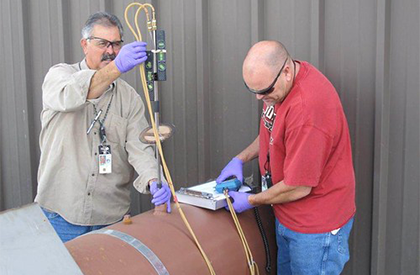
LANL monitors many different pathways in order to assess their impact on workers, the public, animals, and plants. We monitor the air around the Laboratory to ensure our operations are not affecting the air of nearby communities.
The Laboratory expects to emit certain chemical substances to the air based on the materials that are used at each facility. Like similar facilities, LANL has the potential to emit carbon monoxide, sulfur dioxide, nitrogen oxides, volatile organic compounds, and suspended particulate matter.
For more than a decade, monitoring reports have confirmed that the Lab is releasing no air emissions higher than regulations allow.
Monitoring all emissions at specific locations
Ambient monitoring is the systematic, long-term assessment of pollutant levels by measuring the quantity and types of certain pollutants in the surrounding, outdoor air. The purpose of AIRNET, LANL's ambient air monitoring network, is to monitor locations where people live or work. The community of Los Alamos is downwind from LANL, so there are many monitoring stations in and around the town.
AIRNET stations monitor 24 hours a day, 365 days of the year. Particulates are collected on a filter and analyzed every two weeks for identification of analytes and assessment of the potential impact on the public.

Monitoring emissions at the source
Emissions measurement is the process of monitoring materials vented from buildings. Air samples are taken from building exhaust units, called stacks, and are then analyzed for particulate matter, tritium, and radioactive gases and vapors.
A computer model uses the emission data to determine the dispersion.
Stack monitoring is also used to measure emissions that cannot be measured by AIRNET stations.
Real-time air monitoring
Particulate matter is a hazard to human health when the particle size becomes small enough to enter the lungs, e.g., smoke. At LANL, particulate matter concentrations are measured continuously and averaged over 30-minute and 24-hour time periods.
The Neighborhood Environmental Watch Network, also known as NEWNET, updates every 15 minutes and is able to give early indications of increases in radiation due to radioactive particulates in the air.